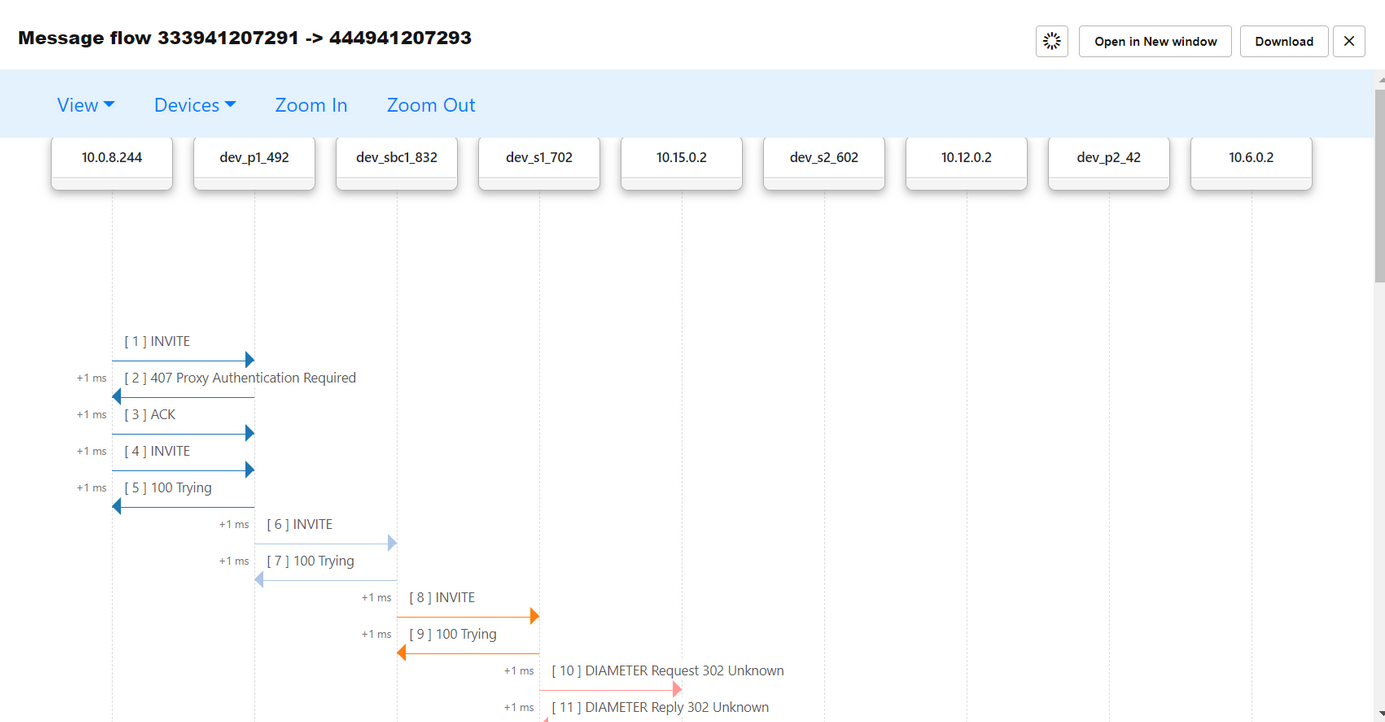General
This section provides an introduction to the web interface, requirements, and frequently used interface elements of Operations Monitor.
Requirements
Operations Monitor runs in any major web browser without extra plug-ins or add-ons.
Note:
Operations Monitor does not require Flash, Java or Microsoft Silverlight.For information on the web browsers on which we test the web interface, see the Session Monitor 5.0 Release Notes.
In order to use the web interface of Operations Monitor, you must enable Javascript. It is recommended that you enable HTTP cookies for features such as remembering login credentials and the state of tables.
Interface Arrangement
On the left side of the Operations Monitor web user interface is the navigation pane. This navigation bar allows access to many of the features of Operations Monitor.
The right side of the Operations Monitor menu bar displays your username, which contains a list with following options:
- My Profile for user settings.
- Settings for administrative features.
- License for the Oracle Communications Session Monitor license terms.
- About the product for the Operations Monitor copyright information.
- Help for access to the Operations Monitor online manual.
- Setup to access the Session Monitor Platform Setup Application.
- Logout to sign out.
Figure 3-1 Interface Arrangement
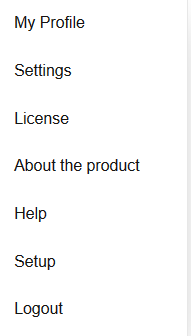
Panels
When you click an element in the navigation pane, a panel appears in the center of the browser window. This panel is a user interface element that displays data.
Many panels can be added to your dashboard for at-a-glance viewing. For more information, see the Dashboard section.
To collapse panels and display titles only, you can click the angle-bracket in the upper-right hand corner.
Figure 3-2 Panels
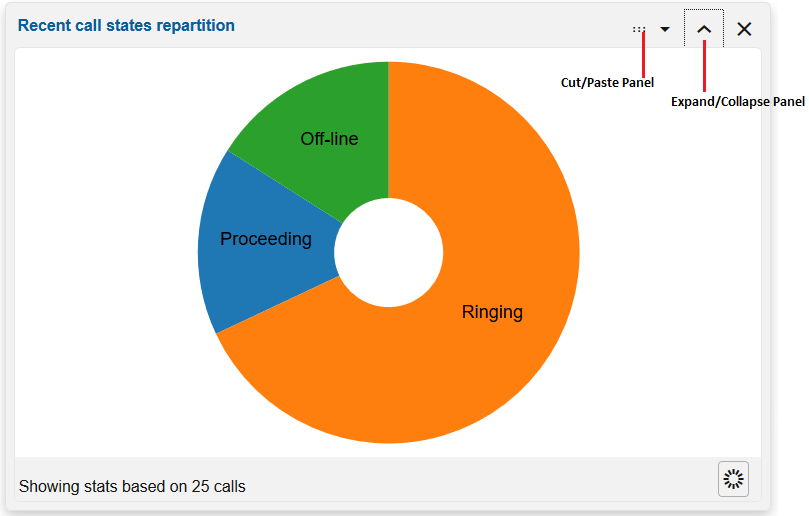
Another common user interface element is the tab panel.
Figure 3-3 Tabs Panel
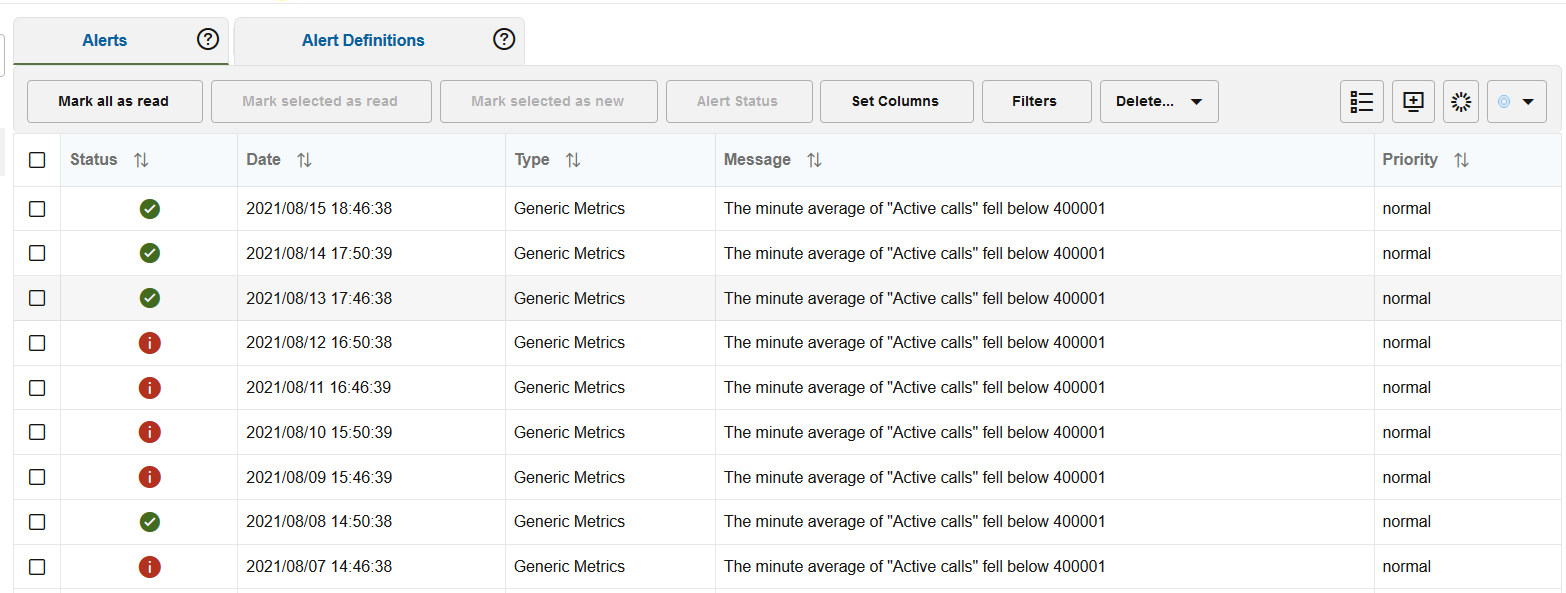
Tooltips and Help
In the title bar of each panel is a ?-symbol. This is the information box. When you hover over the information box, a tooltip provides a brief description of the panel. When you click the ?-symbol, the corresponding section of the user manual appears in a new browser window or tab describing the panel and its functions.
Other user interface elements support tooltips. Hovering over an element with the mouse pointer often brings up a small box explaining the element underneath.
Windows
You may encounter modal windows overlaid on the user interface, similar to the windows of your desktop environment. These windows can be dragged by their title bar, and closed by clicking on the x -symbol or pressing the ESC key. These windows also contain Help and Close buttons at the bottom. The Help button opens the online Help in a new window, describing the current page and its functionality.
Refresh Button
Some areas of the interface contain a Refresh button that controls the update interval for the content of the page, panel, or section. It is identified by a circle of dots (flashing during refresh). Click the button once to refresh the corresponding content. It also contains a drop-down list to set the interval for the Auto Refresh.
Figure 3-4 Refresh Panel Data
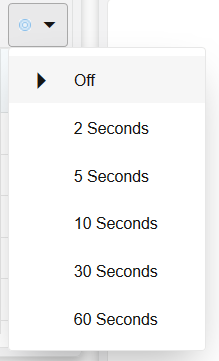
Tables
The tables used in the Operations Monitor user interface offer some features to make the data most useful to you.
To adjust tables, hover above a column header. A down-arrow appears on the right side of the column header. To access the table menu, click the down arrow. The table menu options may differ depending on the data presented in the table.
Filters
Some tables such as Calls, Registrations support the Filters feature. If a table column can be filtered, the Filter button is visible on the table menu bar.
Figure 3-5 Filters

- String Filter Filters the table to display rows that contain the entered value as a sub-string. The input value is not exclusive. This filter menu provides a text field for entering the string.
- Numeric Comparison Filter Restricts the table to rows where the comparison of the column value with the entered numeric results is 'true'. This filter menu provides three fields, one for each of the supported operators ( >, <, =). The = field cannot be used simultaneously with any of the other fields.
- Date Comparison Filter Restricts the table to rows where the column value in the selected date range. This filter menu provides three items for choosing a date ( Before, After, On). With Before and After you can select the rows where the timestamp of the column values lies before and/or after the chosen day. With On you can select the rows of only the chosen day.
- List Filter Restricts the table to rows where the column values contains the selected value. This filter menu provides a list of possible values, which you can choose by selecting or deselecting the corresponding check box.
Hiding Columns in Tables
You can choose to hide certain columns in each table. Click the Set Columns button to see a list of all available columns for this table. Select or deselect the check box to the left of each entry to show or hide the corresponding column.
Pagination
Note the paging toolbar at the bottom of tables. The presence of this toolbar means that the table offers page-wise access to its data:
Figure 3-6 Paging Toolbar

- Click Now to show current data.
- Click Auto Refresh to toggle auto refresh to On or Off. The Auto Refresh button displays animation to indicate that the data is being refreshed.
- Click the Calendar control to show data for a specific date.
- Click the Next or Previous button to go to the next or previous page.
- Click Stop to stop the loading data into the table.
Quick User Inspection
Tables such as Recent calls, Registrations, and the user table in User Devices have context menu entries to quickly trace or track a user. You can right-click on a table row to track or trace the user (in the Recent calls table, you can quickly inspect both the caller and the callee). For more information, see the Recent Calls, Registrations, and User Devices sections.
Figure 3-7 Context Menu for Calls
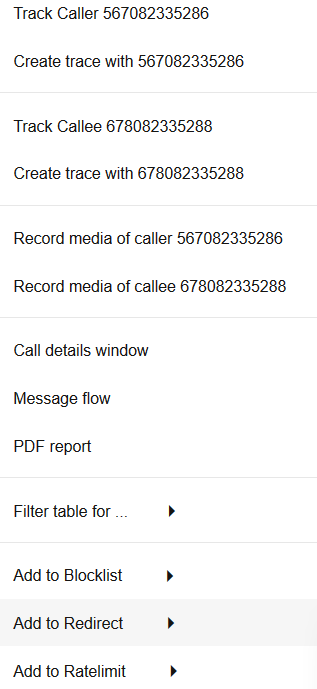
Charts
You may encounter metric charts that display values of a numeric property over a certain time span. Metric charts provide two important features:
- Adjusting the temporal resolution.
- Panning of the visible portion along the time line.
Figure 3-8 Charts

Adjusting the temporal resolution can be achieved using the Zoom buttons in the bottom-right corner of the chart. The buttons correspond to resolutions of five minutes to thirty days.
Operations Monitor's time-lined charts can be updated by clicking the Refresh button. This button also offers Automatic Refresh functionality from the button's drop-down list. For more information, see the Refresh Button section.
Controls Used in Panning a Chart
To pan the chart: click Right scroll or Left scroll buttons and drag. When you click Right scroll, the visible area is shifted further left (further in the past) on the time line. When you drag it to the left, the visible area is shifted further right (nearer to the present) on the time line.
Click Show Interval in Grid to filter the table to the time interval of the chart
Note:
Panning stops the automatic refresh of a chart. Automatic refresh is re-enabled after clicking on the Now button at the bottom of the chart.Figure 3-9 Charts
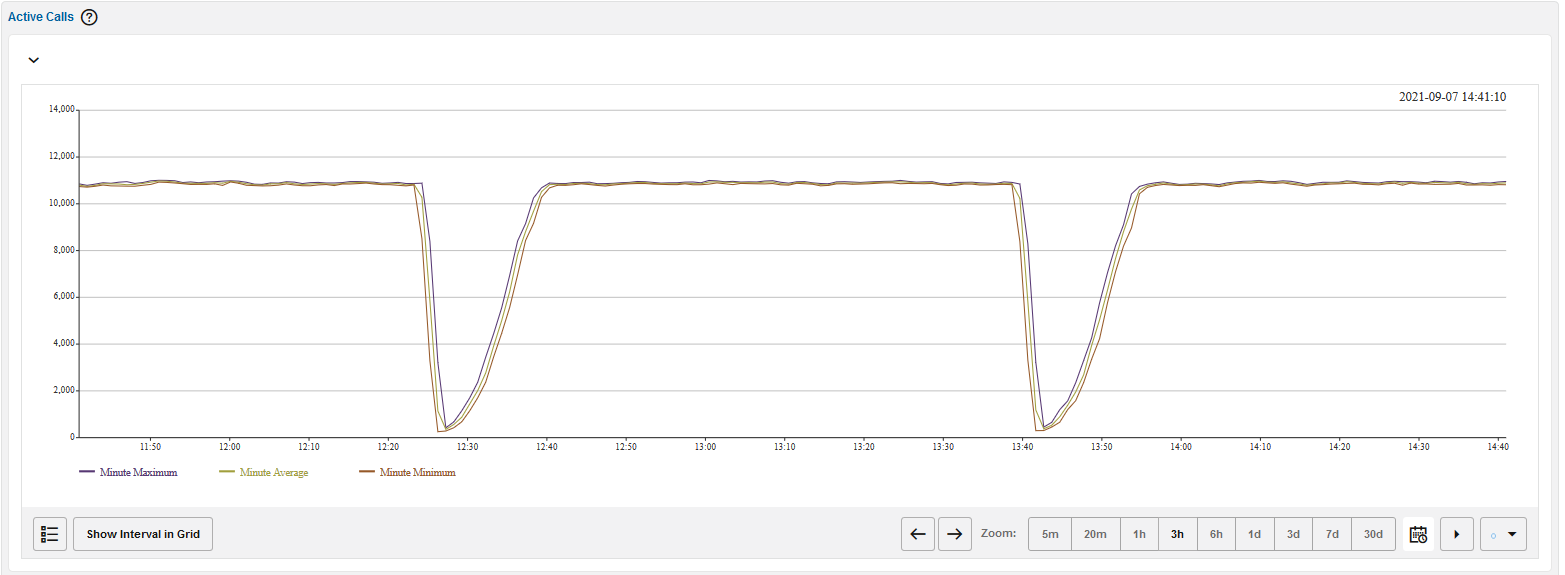
Working with Message Flows
A message flow is a diagram of a call event or a registration event. The message flow displays the network devices involved in the call event or registration event and the protocol messages that have been exchanged between the network devices. For more information on how to configure the hosts on which the network devices run, see the Platform Devices section.
Arranging Message Flows
In order to compare the network devices and protocol messages contained in multiple call events or registration events, you can open multiple message flows to view side-by-side in the same browser window, or you can open multiple message flows to view side-by-side in multiple browser windows.
To adjust the message flow window to fit in your browser screen, view a message flow in a new browser window, resize the message flow window, or view more of the message flow, do one or more of the following:
- To adjust the width of the sequence diagram within the message flow window. In the message flow window's toolbar, click the Zoom in or Zoom out icons accordingly.
- To view more of the message flow without resizing the message flow's window. Inside the message flow window, drag the message flow, or use the message flow window's scroll bar.
- To view the message flow in another browser window. In the message flow window's toolbar, click the Open in a new window button.
- To refresh the message flow window. In the message flow window's toolbar, click the Refresh button. For more information, see the Refresh Button section.
- To select the parameters that must appear in the Device map, click the View drop-down list and select the parameters.
- To select the devices that must appear in the Device map, click the Devices drop-down list and select the devices.
Customizing the Display of Contents within Message Flows
The contents displayed in the sequence diagram, protocol messages, and network devices within the message flow are customizable.
To customize the display of contents within message flows:
Customizing the Visibility and Position of Network Devices within Message Flows
By default, all networking devices are displayed in the message flow in the order of the call event transaction or the registration event transaction. The visibility and position of a network device is customizable in a message flow.
To customize the visibility and position of network devices within message flows:
Figure 3-11 Devices in the Device Map
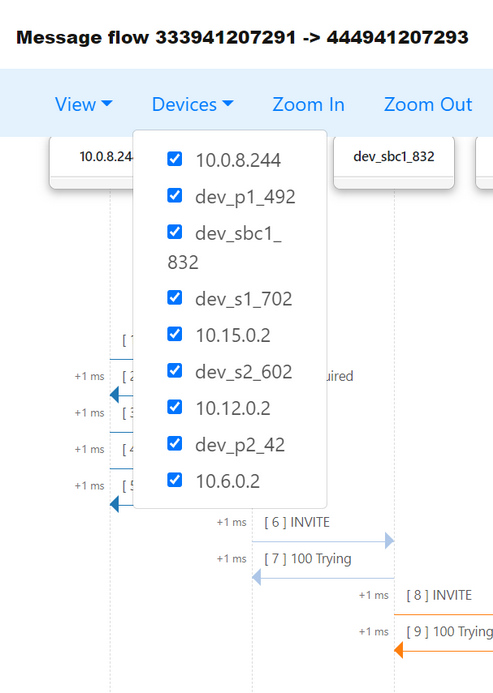
Viewing Individual Protocol Messages
Protocol messages of the sniffed packet can be viewed and saved. For more information on saving a protocol message, see "Saving a Message Flow as an HTML File".
Each protocol message is numbered in brackets in the order of the call event transaction or the registration event transaction between the network devices.
To view individual protocol messages:
Figure 3-12 Individual Protocol Message Window
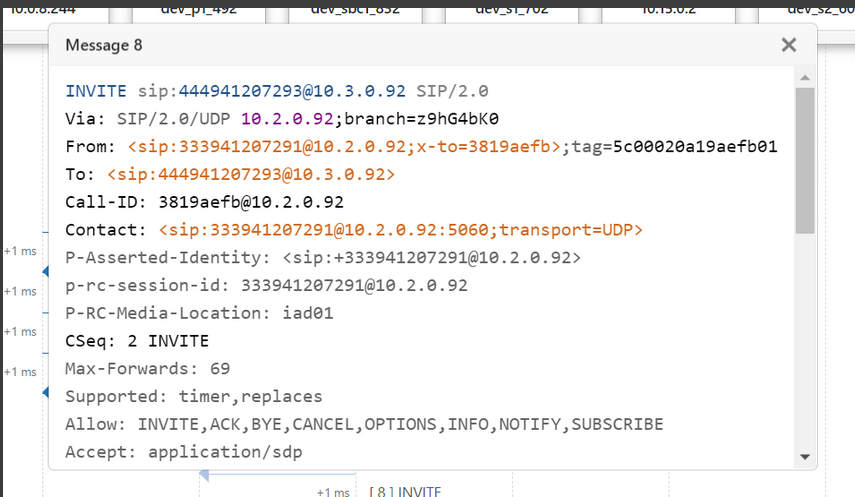
Note:
The maximum number of messages for a flow is limited. You can change the limit value in System Settings. For more information, see "System Settings".Viewing Call Event ISUP Protocol Messages
When a call event contains ISDN User Part (ISUP) binary content, you can view the ISUP binary content as human readable text.
To view call event ISUP protocol messages:
Saving a Message Flow as an HTML File
You can save a message flow as an HTML file on your computer to view at another time or share with others. This is important when diagnosing issues.
To save a message flow as an HTML file:
Saving a Call Event Message Flow as a PDF File
You can save a call event message flow as a PDF file.
To save a call event message flow as a PDF file:
Note:
Because the decoded binary ISUP content can be lengthy, only two levels of information are displayed in the PDF report.BICC Support
You can distinguish between ISUP and BICC messages by the protocol name looking at the Ladder Diagram section.
Note:
- The platform device type must be STP to correlate BICC and ISUP messages.
- The platform device type must be SGW to correlate BICC and SIP messages.
OCOM supports correlation among BICC, SIP, and ISUP messages. Apps such as Call count, Calls containing keywords, response code search apply to BICC calls in the same way as they apply to ISUP calls. Export of BICC calls is supported.
Limitations: ISUP and BICC protocols have very similar set of messages and hence, in the GUI, there is no way to differentiate ISUP and BICC signaling messages in a correlated call. A distinction between BICC and ISUP calls can be made by looking at the Message Flow information. Here messages are marked as 'ISDN User Part' and 'Bearer Independent Call Control'. There is also a difference in the size of the CIC for a BICC and ISUP message.
System Settting to Enable BICC Support
Support for BICC Protocol is the system setting that allows you to enable or disable the support of BICC signaling messages by OCOM.
Note:
The existing system settings which are applicable to ISUP protocol messages are applicable for the BICC protocol messages also. The system settings associated with ISUP messages have similar impact on ISUP and BICC messages.Viewing BICC Calls in the Recent Calls Page
In the Calls Page You can filter BICC calls based on Originating Point Code (OPC) and Destination Point Code (DPC).
BICC messages along with OPC/DPC values are displayed in Recent Calls table. As the payload section of ISUP and BICC frames are very similar and these messages cannot be differentiated by protocol/message name in the GUI, as of now.
Figure 3-14 Viewing BICC calls in the Recent Calls Page

Viewing BICC Messages in the Call Info Window
A list of BICC messages along with it's details are shown completely in the Messages tab of the Call Info window.
In the ladder diagram, detail of each BICC message is shown.
BICC Advanced Metrics
The following is the list of KPIs that are updated when BICC messages are received.
In 'Advanced metrics', the following list of KPIs can be defined with certain range of Q 850 cause codes.
- Number of ISUP Q 850 cause codes
- Number of calls with Q 850 cause codes
- Number of ISUP calls with Q 850 cause codes
- Number of ingress legs with Q 850 cause code
- Number of ISUP ingress legs with a Q 850 cause code
